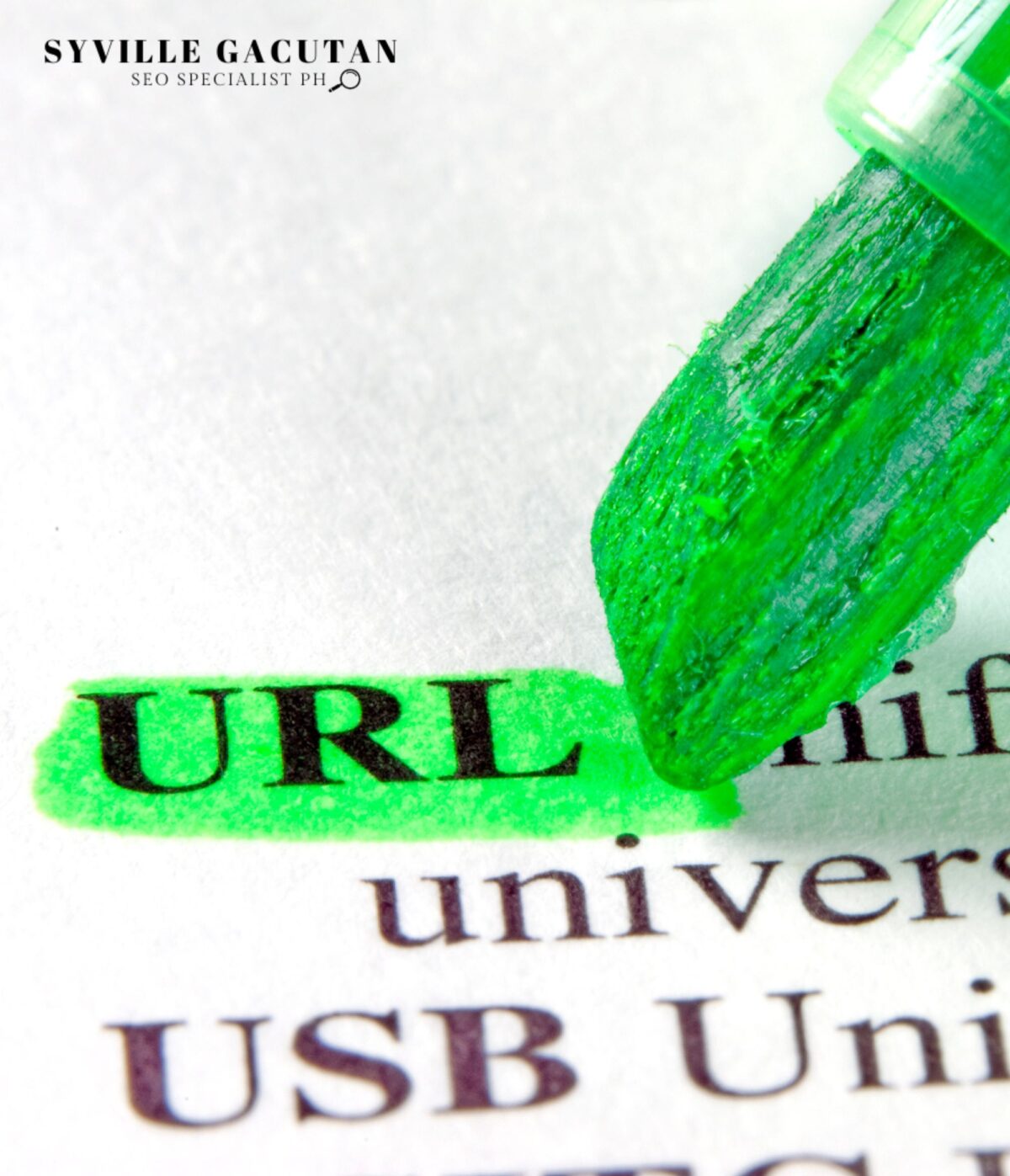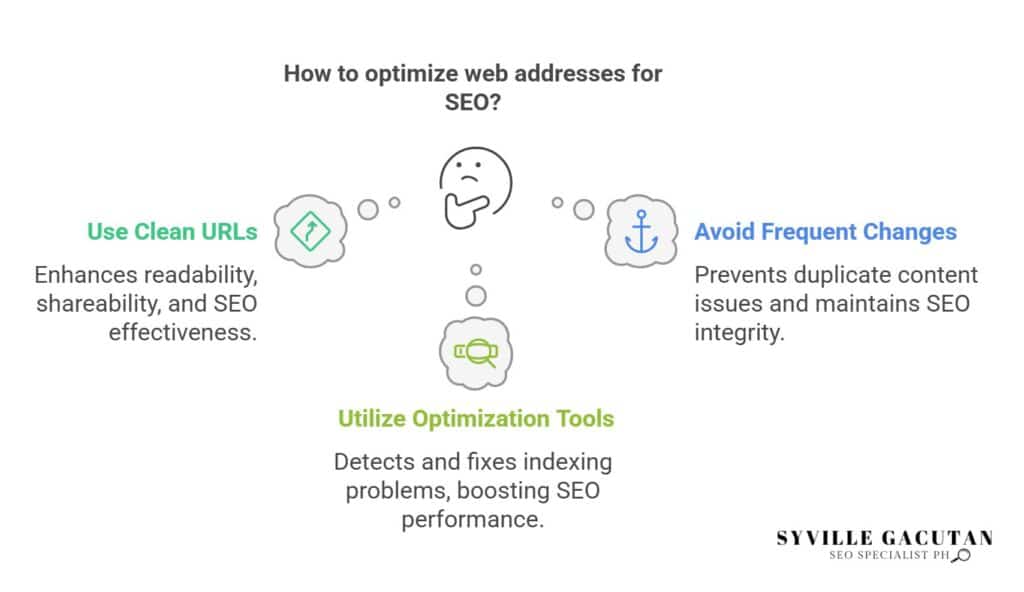
The impact of URL structure on SEO is profound, with clean URLs generally outperforming dynamic URLs. Clean URLs, being concise and keyword-rich, facilitate better indexing and offer improved readability for both users and search engines. Their straightforward nature avoids content duplication problems and boosts click rates because of their openness. In contrast, dynamic URLs, often laden with complex parameters, can confuse search engines and users, leading to poorer SEO performance. They frequently cause challenges in indexing and user engagement due to their complexity and lack of clarity. To explore further how URL optimization can influence your site’s ranking potential, consider deeper insights.
Key Takeaways
- Straightforward web addresses boost search engine optimization. They are brief informative, and packed with relevant keywords. This approach elevates search rankings & encourages user interaction.
- Changing web addresses frequently create problems with duplicate content. This hurts search engine optimization efforts and how search engines index the site.
- Clean URLs are easier for users to read, share, and remember, boosting click-through rates and user experience.
- Dynamic URLs’ complex structure can hinder SEO by making it difficult for search engines to distinguish unique content.
- Tools that optimize URLs assist in detecting and fixing indexing problems. This enhances the overall performance of URL varieties for search engine optimization purposes.

Understanding URL Structures
Grasping URL structures is crucial for web development and search engine optimization. URLs act as online addresses guiding users and search engines to particular internet resources. A well-structured URL is not only pivotal for navigation but also for enhancing search engine optimization (SEO) efforts.
Two primary types of URLs exist: dynamic URLs and static URLs, each playing a distinct role in the digital landscape.
Dynamic URLs are created from scripts and database queries, often containing parameters and session IDs. These URLs might appear complicated, with characters such as “?”, “&”, and “=”. Though dynamic URLs are efficient for content management systems and database-driven sites, they can be less intuitive for users and search engines to interpret. The intricate nature of the task can occasionally obstruct the creation of URLs optimized for search engines. These search engines may encounter difficulties in linking such URLs to pertinent content.
On the other hand, static URLs are fixed and do not change unless edited by a webmaster. They typically present a cleaner and more concise path to the content, which can significantly contribute to a more straightforward user experience and improved search engine rankings. Static URLs often contain keywords relevant to the content, which can enhance their SEO value.
An effective URL structure balances the needs of both users and search engines. By designing seo-friendly urls that are easily readable and logically organized, web developers can improve a site’s visibility and accessibility.
Ultimately, understanding and implementing optimal URL structures is a critical component of successful search engine optimization strategies.
What Are Clean URLs?
In the realm of web development, clarity is embodied in the concept of clean URLs. A clean URL is a web address that is easily readable by humans and search engines alike, typically devoid of complex query strings and special characters. These URLs are often favored for their concise structure and inherent friendliness, making them more appealing in both static or dynamic web environments.
| Attribute | Clean URL Example | Benefit |
| Readability | /about-us | User-friendly |
| URL Length | Short and concise | Easier sharing and memorization |
| SEO Optimization | Keywords included | Improved search engine ranking |
| Dynamic Content | /product/shoes | Handles dynamic content seamlessly |
| Duplicate Content Issues | Minimizes risk | Better indexing by search engines |
Clean URLs are often described as “friendly URLs” because they are structured in a manner that communicates the content of the page clearly. This structure not only enhances user experience but also aids in SEO efforts. For instance, a URL like “/about-us” is not only succinct in url length but also immediately tells both users and search engines what to expect on the page.
Moreover, clean URLs help mitigate duplicate content issues, a common pitfall in SEO that can lead to penalties or poor indexing outcomes. By maintaining a standardized format, these URLs ensure that each page is unique and easily distinguishable. This is especially beneficial when dealing with dynamic content, as clean URLs can seamlessly integrate parameters without compromising readability.
Ultimately, clean URLs are an integral part of effective web development, offering simplicity and clarity that can significantly enhance both user experience and search engine visibility.
Exploring Dynamic URLs

Dynamic URLs, often generated by scripts or applications, are characterized by their use of query strings and parameters to deliver tailored content to users. These URLs are typically the result of database-driven sites and are prevalent in e-commerce platforms and content management systems (CMS).
Unlike static URLs, which remain constant and clear, dynamic URLs change based on user interaction and the data being requested. This dynamic nature allows websites to efficiently manage and serve large amounts of content without the need for separate static pages for each item or interaction.
When considering the SEO benefits of dynamic URLs, it’s essential to weigh their potential impact. Search engines like Google can index dynamic URLs, but historically, there has been a preference for clear URLs that are more user-friendly and easier to index.
Dynamic URLs often include characters such as “?”, “&”, and “=”, which can be perceived as less clean compared to static URLs. However, advancements in search engine algorithms have improved their capability to handle and understand dynamic URLs, reducing some previous concerns.
In the static vs dynamic URLs debate, one must consider the functionality and flexibility dynamic URLs offer. They enable a personalized user experience and are crucial for sites that require real-time data display, like online stores or news sites.
While clear URLs are generally favored for their simplicity and readability, dynamic URLs provide the technical backbone for websites needing complex data interactions. Understanding the role and operation of dynamic URLs is crucial for webmasters aiming to optimize site performance and ensure efficient search engine indexing.
SEO Implications of Clean URLs

Amid the many factors influencing search engine optimization (SEO), the structure of URLs plays a pivotal role, particularly when considering clean URLs. Clean URLs, often referred to as static URLs, are devoid of complex query strings and special characters, making them more readable to both users and search engines. These URLs typically incorporate relevant keywords that describe the page’s content, thus qualifying as keyword-rich URLs. The SEO implications of such clean URLs are manifold and largely positive.
Firstly, clean URLs contribute to improved user experience. When URLs are concise and descriptive, users can easily infer the content of the page by simply glancing at the URL itself. This increased transparency can lead to higher click-through rates, as users are more likely to engage with links that clearly match their search intent.
Moreover, clean URLs are inherently more preferable to search engines like Google, which prioritize user-friendly structures. Search engines can more effectively crawl and index pages with clean, keyword-rich URLs, enhancing the page’s visibility. This advantage is not as easily obtained with dynamic URLs, which often contain complex parameters that can confuse both users and search engines.
Additionally, clean URLs are more conducive to link sharing and bookmarking. A URL that is easy to read and remember is more likely to be shared across various platforms, thus increasing its reach and authority.
SEO Challenges of Dynamic URLs

Many factors can complicate the optimization of dynamic URLs for search engines, presenting unique challenges for webmasters. Unlike static URLs, which are typically clean and straightforward, dynamic URLs often include complex structures with numerous URL parameters. These parameters can significantly impact SEO performance by making it difficult for search engines to crawl and index a website efficiently.
When a URL contains multiple parameters, it can create a seemingly endless number of unique pages, leading to duplicate content issues and diluting a website’s search engine ranking potential. Search engines may struggle to differentiate between useful content and redundant pages when faced with dynamic URLs. This challenge is compounded by the fact that dynamic URLs are often less descriptive than their static counterparts, making it harder for search engines to determine the relevance of a page’s content.
As a result, webmasters may find that pages with dynamic URLs rank lower in search results compared to pages with static URLs, which can adversely affect overall SEO performance. Moreover, dynamic URLs can present difficulties in terms of link sharing and user engagement. When URLs are long, complex, and include various parameters, they are less likely to be clicked on or shared.
This lack of engagement can further hinder a site’s search engine ranking, as search engines often consider click-through rates and user interactions as part of their ranking algorithms.
User Experience Considerations

Optimizing URLs not only bears significance for search engine rankings but also plays a vital role in shaping user experience. A well-structured URL can significantly enhance the user’s interaction with a website. Dynamic URLs, often generated by complex systems, can sometimes be less intuitive for users due to their complex structures. On the other hand, SEO-friendly URLs, characterized by relevant keywords and simplicity, can improve navigation and lead to a more seamless user experience.
For users, the ease of remembering or sharing a URL contributes to its usability. A unique URL that clearly indicates the content of the page is more likely to be trusted and shared. This faith holds great importance when aiming to cultivate devoted users possessing potential to directly influence successful conversion outcomes.Moreover, clean URLs, which are devoid of confusing characters and session IDs, provide users with a clear idea of the page’s subject even before clicking on it.
Here is a comparison to illustrate these considerations:
| Aspect | Dynamic URLs | SEO-Friendly URLs |
| Structure | Complex, includes parameters | Simple, includes keywords |
| User Trust | May appear confusing | Clear and descriptive |
| Memorability | Difficult to remember | Easy to recall and share |
| Relevance | Often lacks context | Uses relevant keywords |
Indexing and Crawling Factors

When it comes to indexing and crawling, the structure of a URL plays a critical role in how search engines interpret and prioritize web pages. URLs act as the fundamental identifiers for web pages, guiding search engines in understanding the content and relevance of each page. The distinction between dynamic URLs and static URLs significantly impacts their SEO value and ease of indexing.
Dynamic URLs, often characterized by long strings of parameters and session IDs, pose challenges for search engines during the indexing process. These URLs can be difficult to decipher, as they may contain unnecessary information that does not contribute to the actual content of the page. Consequently, search engines may struggle to recognize the unique content behind dynamic URLs, potentially leading to inefficient indexing and missed SEO opportunities.
Despite improvements in search engine algorithms, static URLs generally offer clearer signals. In contrast, static URLs are typically shorter, more descriptive, and easier for search engines to crawl and index. They often contain keywords relevant to the content, thereby enhancing their SEO value. This straightforward structure aids search engines in quickly identifying the subject matter of the page, subsequently boosting its likelihood of being indexed correctly and ranked favorably.
Moreover, the simplicity of static URLs not only aids in search engine indexing but also contributes to a cleaner and more user-friendly web experience. Users are more likely to share and link to static URLs, indirectly enhancing their SEO performance.
Best Practices for URL Optimization

Crafting well-structured URLs is a cornerstone of effective URL optimization, significantly influencing both search engine visibility and user experience. Clean URLs, which are short, descriptive, and devoid of unnecessary characters, are often favored in SEO best practices. They provide clarity to both users and search engines, making it easier to understand the content and context of a webpage. In contrast, dynamic URLs, typically generated from database-driven websites with parameters such as “?id=123”, can pose SEO issues due to their complexity and lack of readability.
To optimize URLs effectively, it is essential to incorporate relevant keywords that accurately reflect the content of the page. This not only aids search engine algorithms in understanding the page’s relevance but also enhances user comprehension.
Consistency in URL structure across the website is crucial; using a predictable pattern helps search engines crawl and index content more efficiently. Eliminating superfluous parameters and session IDs from dynamic URLs can mitigate potential SEO issues.
Utilizing URL rewriting techniques or configuring server settings enables dynamic URLs to be transformed into cleaner, more user-friendly versions. This approach not only improves search engine optimization but also enhances the overall user experience by providing easily shareable and memorable links.
Furthermore, maintaining a logical hierarchy in the URL structure—reflecting the website’s architecture—can improve navigability and assist in establishing content relationships.
These best practices for URL optimization emphasize simplicity, relevance, and consistency, ensuring that both clean and dynamic URLs contribute positively to a website’s SEO performance. By implementing these strategies, businesses can enhance their online presence, driving more organic traffic and improving user engagement.
Tools for URL Analysis

A crucial aspect of effective URL optimization is employing robust tools for URL analysis. These tools empower webmasters to dissect and enhance URLs, which can significantly impact on SEO. By understanding the differences between dynamic URLs and static URLs, businesses can make informed decisions to improve online visibility.
Here are four essential tools that facilitate comprehensive URL analysis:
- Google Search Console: This indispensable tool provides insights into how Google interprets your URLs. It identifies indexing issues and suggests improvements for URL rewriting by analyzing keywords in the URL. This enhances the likelihood of ranking higher in search results, particularly when switching from dynamic URLs to more SEO-friendly static URLs.
- Screaming Frog SEO Spider: Known for its versatility, Screaming Frog crawls website URLs and offers detailed reports on meta data, URL structures, and more. It assists in evaluating the effectiveness of URL rewriting strategies, ensuring that keywords in the URL are optimally placed to boost SEO impact.
- Ahrefs: This tool excels in backlink analysis but is equally proficient in URL analysis. Ahrefs allows users to scrutinize URL structures, compare static and dynamic URLs, and understand the competitive landscape. Its comprehensive data aids in refining URLs for better search engine performance.
- Moz Pro: Moz Pro provides a suite of tools for analyzing URL metrics, including page authority and keyword optimization. It highlights the impact of URL structures on SEO, guiding users towards implementing effective URL rewriting strategies to maximize visibility.
Utilizing these tools strategically can lead to substantial improvements in search engine rankings, ultimately benefiting any digital marketing strategy.
Final Thoughts
In conclusion, the structure of URLs plays a critical role in both SEO performance and user experience. Clean, keyword-rich URLs are preferred by search engines for their simplicity, readability, and ease of indexing, while dynamic URLs, though flexible, often complicate SEO efforts with their complex structures and potential for duplicate content. By optimizing URLs to be clear, concise, and relevant to the page’s content, websites can improve both their search engine rankings and user engagement.
Need expert help in optimizing your URL structure for better SEO performance? Syville Gacutan, an experienced SEO Specialist in the Philippines, can guide you in transforming your URLs into clear, search-engine-friendly formats, enhancing your site’s visibility and user experience. Connect with Syville today and take your website’s SEO to the next level!